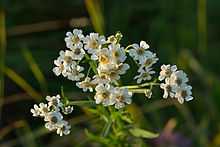Achillea ptarmica
| Sneezewort | |
|---|---|
 | |
| Scientific classification | |
| Kingdom: | Plantae |
| (unranked): | Angiosperms |
| (unranked): | Eudicots |
| (unranked): | Asterids |
| Order: | Asterales |
| Family: | Asteraceae |
| Genus: | Achillea |
| Species: | A. ptarmica |
| Binomial name | |
| Achillea ptarmica L. | |
| Wikimedia Commons has media related to Achillea ptarmica. |
Achillea ptarmica (sneezewort, sneezeweed, bastard pellitory, European pellitory, fair-maid-of-France, goose tongue, sneezewort yarrow, wild pellitory, white tansy) is a species of herbaceous perennial flowering plant in the genus Achillea. It has loose clusters of white, button-like flowers that bloom from June to August. Its dark green leaves have finely toothed margins.
The name ptarmica comes from the Greek word ptairo (=sneeze) and means 'causes sneezing'.
Like many other plants, the sneezewort's pattern of development displays the Fibonacci sequence.[1]
Uses
Leaves can be eaten raw or cooked. A. ptarmica yields an essential oil that is used in herbal medicine. The leaves are used as an insect repellent.[2]
The plant is poisonous to cattle, sheep, and horses. Symptoms are generally slow to develop, and include fever, rapid pulse, difficulty breathing, weight loss, drooling, spasms and loss of muscular control, and convulsions.
Cultivation
This is a hardy, drought-tolerant plant that prefers full sun and moist but well-drained soil. Propagation is by sowing seed or division in Spring.
See also
References
- ↑ Jill Britton (7 May 2005). "Fibonacci Numbers in Nature".
- ↑ "Achillea ptarmica". 2005.
- Bailey, L. H. (2005). Manual of Gardening (Second Edition). Project Gutenberg Literary Archive Foundation.
- Wood, John (2006). Hardy Perennials and Old Fashioned Flowers. Project Gutenberg Literary Archive Foundation.